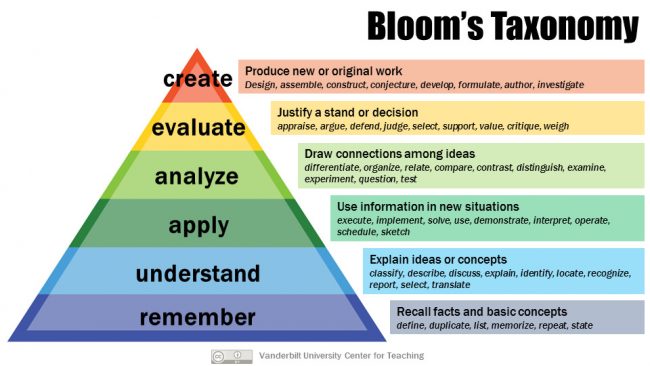What is
Revised Bloom’s Taxonomy
The revised Bloom’s Taxonomy emphasizes students’ learning outcomes through the use of refined terms. The revised taxonomy is a refreshed take on Bloom’s Taxonomy from 1956, which examined cognitive skills and learning behavior. The original framework was proposed by Benjamin Bloom who believed, “education must be increasingly concerned about the fullest development of all children and youth.” Changes to terminology, structure and emphasis are a part of the revised approach. Nouns such as evaluation or synthesis are now replaced with verbs such as creating or evaluating, respectively. With structure, “creating” now becomes the highest level—the area meant for generating ideas or constructing a new point of view. Emphasis has also changed, whereby the taxonomy is aimed at wider audiences and attempts to be more universal beyond grade school.
What are the different levels of the revised Bloom’s Taxonomy? Revised Bloom’s taxonomy refers to the emphasis on two learning domains that make up educational objectives: cognitive (knowledge) and affective (attitude). The revised taxonomy focuses on six levels: remember, understand, apply, analyze, evaluate and create. Bloom’s action verbs are also used when developing learning outcomes. Here’s a breakdown of each tier in the Bloom’s Taxonomy framework.
Remember refers to recalling information from long-term memory, such as recalling the stages of mitosis. Learning outcome verbs for this level include ‘cite,’ ‘define’ and ‘label.’
Understand involves showing comprehension of a given concept or fact, such as explaining why a chemical reaction occurs. Learning outcome verbs for this level include ‘compare,’ ‘differentiate,’ and ‘paraphrase.’
Apply refers to translating concepts learned in the classroom to other academic or non-academic scenarios, such as using a math formula to determine an appropriate budget. Learning outcome verbs for this level include ‘examine,’ ‘experiment,’ and ‘solve.’
Analyze refers to drawing parallels between ideas and using critical reasoning to determine patterns and connections, such as differentiating between collective and individualistic societies. Learning outcome verbs include ‘classify,’ ‘identify,’ and ‘integrate.’
Evaluate involves rationalizing based on the educational information and criteria presented to them, such as justifying a fictional court ruling. Learning outcome verbs for this level include ‘conclude,’ ‘consider,’ and ‘rank.’
Create, the final level of the revised Bloom’s Taxonomy model, involves putting separate elements together to form a detailed final product, such as writing a book of short stories based on literature principles analyzed throughout the course. Learning outcome verbs for this level include ‘compile,’ ‘generate,’ and ‘modify.’
These verbs refer to the cognitive process that students encounter and the knowledge that they work with. For instance, a verb under the ‘remember’ category may ask students to recall how to perform CPR where a verb under the ‘create’ category may ask students to design an effective project workflow.

Additional resources